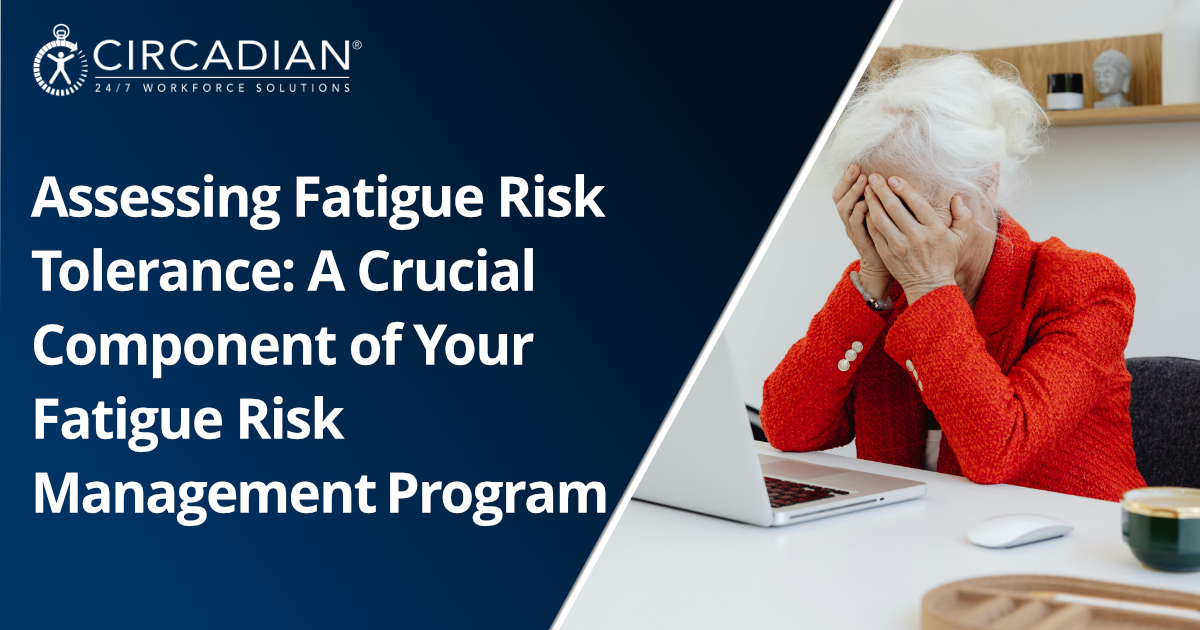Reducing risk factors for fatigue is essential for maintaining a safe and productive work environment. Fatigue-related incidents can lead to costly accidents, lost productivity, and serious safety concerns. Even small shifts in our sleep-wake cycle can significantly impact performance and safety, making fatigue a common but often underestimated risk in many industries.
Here are 3 proven strategies to reduce fatigue risk factors in your workplace:
1 - Educate and Train Employees on Personal Sleep/Fatigue Management
One of the most effective ways to reduce fatigue risk in the workplace is through education and training. Equip your workers with the knowledge and tools they need to optimize their sleep and manage fatigue.
This includes providing tips on how to improve sleep quality, recognizing the signs of fatigue, and using countermeasures like naps, breaks, and caffeine strategically. Educating management on how to spot fatigue in their teams is equally important, allowing them to intervene and mitigate risks before accidents occur.
Actionable Tips for Employees:
- Follow a consistent sleep schedule, even on days off.
- Create a sleep-friendly environment with minimal light and noise.
- Avoid heavy meals, alcohol, and caffeine close to bedtime.
Fact: Workers who regularly receive sleep/fatigue training have fewer accidents, make fewer errors, and experience improved overall performance. The National Sleep Foundation reports that well-rested employees are more productive and engaged.
2 - Conduct a Fatigue Risk Assessment (FRA)A Fatigue Risk Assessment (FRA) is a crucial tool for understanding the state of fatigue management in your organization. By auditing current fatigue risks and management efforts, an FRA can provide valuable insights into which employees are most at risk and how existing schedules may be contributing to fatigue.
An FRA also helps measure the effectiveness of any interventions you've implemented to reduce fatigue. This systematic approach allows for targeted improvements and can also demonstrate your commitment to safety when presenting to inspectors and regulators.
Benefits of a Fatigue Risk Assessment:
- Identifies employees and shifts with the highest risk of fatigue-related accidents.
- Provides measurable data on the impact of shift schedules and workloads on fatigue levels.
- Serves as a standardized method for managers to assess and address fatigue risk.
- Ensures compliance with safety standards and government regulations by documenting fatigue management initiatives.
Pro Tip: Regularly updating your FRA can help track improvements and ensure that your strategies for reducing fatigue remain effective as your workforce evolves.
3 - Implement a Comprehensive Fatigue Risk Management Plan (FRMP)Creating a Fatigue Risk Management Plan (FRMP) is essential for any business operating with extended hours or shift work. This comprehensive plan provides a structured approach to reducing risk factors for fatigue by defining clear policies and procedures to mitigate fatigue risks.
An FRMP offers practical guidance for assessing current fatigue levels and outlines specific steps for managing and reducing fatigue over time. This can include adjusting shift schedules, allowing more breaks, and implementing fatigue monitoring technologies. The plan also serves as a foundation for ongoing education and support for employees.
Key Components of an FRMP:
- Shift scheduling policies: Develop schedules that minimize fatigue, such as limiting consecutive night shifts and ensuring proper rest periods.
- Fatigue monitoring tools: Implement technology to monitor alertness levels in real-time, helping supervisors detect and address fatigue before it becomes a safety issue.
- Employee engagement: Involve your workforce in the design of fatigue management strategies to increase buy-in and effectiveness.
Reducing fatigue-related risks in the workplace isn't just about compliance—it's about fostering a safer, healthier, and more productive environment. By educating employees, conducting comprehensive fatigue risk assessments, and implementing a Fatigue Risk Management Plan, your organization can significantly reduce risk factors for fatigue and prevent costly accidents and errors.
Interested in learning more about reducing fatigue risk in your operation? Contact us today to discuss tailored solutions for your workforce and explore the best strategies to improve safety and performance.
____________________________________
BONUS: Fatigue Risk and Daylight Savings Time
- There are nearly 68% more workdays lost to injuries that occur in the days immediately following the time change.
- Road accidents and the severity of workplace injuries see a significant spike after DST.
But the risks of disrupted sleep-wake cycles don't just apply to DST. For many industries, workers are regularly shifting their sleep schedules due to rotating shifts, overtime, and cross-time-zone travel. These changes put employees at higher risk for fatigue-related errors and accidents. Here are three strategies for reducing risk factors for fatigue in your organization.
Interested in Shiftwork, Scheduling & Fatigue Risk Management Best Practices?
Subscribe to CIRCADIAN's email list for cutting-edge information, updated research findings, and easy-to-implement strategies, all tailored to optimize the health, safety, and performance of your shiftwork and extended hours operations.
Join our community of 32,000+ industry leaders and receive practical tips and expert insights to optimize your 24/7 workforce.











